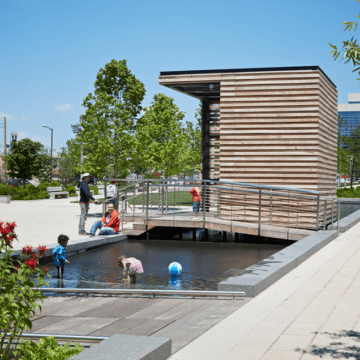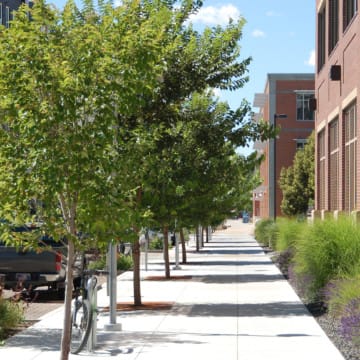Promenade Park
Promenade Park has transformed the north and south banks of the St. Marys River by creating a signature public space that demonstrates the value of resilient design. The park has become a symbol of community, environmental connection, and rebirth for downtown Fort Wayne, Indiana. Expanding residents’ and visitors’ access to the riverfront while enhancing protective measures for flood risk, the park has also sparked new downtown businesses and jobs for locals. Due in part to extensive community input, Promenade Park has created a sense of belonging and a place where neighbors can come together to rest, reflect, and make meaningful connections with the city’s rivers.
Context
The location of Fort Wayne, at the confluence of three rivers, was important to the establishment of the city in the late 1700s. In the early 20th century, Fort Wayne’s rivers—the St. Marys River, the St. Joseph River, and the Maumee River—were community assets that powered mills and provided transportation before frequent flooding led the community to “wall off” the rivers with levees during the 1980s. During that period, new development largely turned its back on the rivers rather than celebrating them, and overgrown vegetation prevented residents from regularly seeing and accessing the waterfront.
A turning point was reached in 2011 when Mayor Tom Henry made riverfront development a priority for the city. To shape and guide this development, the Riverfront Fort Wayne initiative was created with strong support from the mayor and city council. After a comprehensive study of the city’s rivers, the 4.5-acre (1.8 ha) future site of Promenade Park was identified for the first phases of riverfront development.
To ensure meaningful cross-sector collaboration from the very beginning, the city of Fort Wayne worked closely with the Riverworks Design Group, a partnership of designers, architects, engineers, and storytellers. Committed to making Promenade Park a world-class destination, the partnership was formed exclusively to execute the planning and design for the park.
The creation of the park was significant not only in reducing flood risk but also in forging a connection between Fort Wayne’s urban center and the riverfront. Opened in 2019, the park is connected to the city’s Rivergreenway, which comprises 25 miles (40 km) of riverside paths, serving walkers, bikers, and hikers. Before the park’s existence, there were few access points to the river and they were difficult to reach, but now they are the cornerstone of the community. Additional amenities—such as canoes and kayaks, boat tours, an accessible playground, a splash pad, ping-pong tables, a band shell for performances, an amphitheater, and a 6,400-square-foot (595 sq m) pavilion—ensure that there is something for each of the 50,000 annual visitors to enjoy.
The park’s design also encourages connections between nature and people of all abilities. From the very beginning of the design process, project team conversations were held with community members, which led to the inclusion of universal design principles. From large bench swings to curved hillside seating that fosters conversations, Promenade Park offers a mental break for downtown workers and residents alike in a natural environment.
Resilience and Sustainability Strategies
Promenade Park demonstrates the value of revitalizing natural spaces for public benefit while prioritizing resilience and sustainability strategies to ensure the park’s longevity for generations to come.
Some of the park’s notable resilience and sustainability strategies include the following:
- Supporting local ecology: The construction of the park was carefully executed in order not to disrupt the existing environment. The strategic placement of local, native plants supported the existing vegetation while providing habitat for local species. Certain plantings in the park can withstand being underwater for extended periods of time, such as during flood events. In addition, structural supports for the Tree Canopy Trail, a nearly 600-foot-long (183 m) canopy walk through the trees, were placed to keep wetlands intact and weave the trail around the trees—any trees removed for the trail were replaced at a higher ratio.
- Addressing flood risk: The park’s large stairs leading to the riverfront can safely store water during flood events, lessening the effects of extreme weather on the surrounding community. Even the children’s playground doubles as a resilient design feature with its grade change providing climbing and sliding play opportunities while being able to withstand high water levels during floods. The park’s construction was responsible for the creation of more than 3,000 cubic yards (2,294 cubic m) of additional storage for water from storms and floods, protecting surrounding businesses and neighborhoods that were once susceptible to flooding.
- Community engagement: Over the course of five years leading up to the park’s construction, the collective of local firms behind the park’s development—the Riverworks Design Group—held numerous public meetings to ensure that the park was developed to reflect the history and culture of the city. Through a mix of community engagement activities including focus groups, surveys, and boat tours along the river, over 8,000 community members contributed their thoughts and ideas to help shape the park.
- Accessible design: It was vital to the community and creators of the park for everyone to be able to use the space freely and easily. Turnstone, a community organization that provides programs to empower people with disabilities, helped organize focus groups with blind athletes and people with sensory disorders and Parkinson’s disease. Input from these focus groups informed many design decisions. Notable features of the park include gradual sloping walking paths with five-foot (1.5 m) turn radii to accommodate wheelchairs, accessible play features, wheelchair seating at tables, patterns in the pavilion floor to accommodate challenges associated with Parkinson’s disease, and a tactile ribbon running along the park’s path that is paired with a 3D-printed map providing easy wayfinding to those with visual impairments.
Value Proposition
Avoided losses. Fort Wayne has long grappled with flooding due to heavy precipitation, storms, and its fluctuating rivers. In 1982, the city experienced one of its worst floods and estimated damage costs totaled around $57 million. The team behind Promenade Park took the park’s design and construction as an opportunity to enhance flood resilience by implementing a variety of protection and mitigation strategies. Given the surrounding neighborhoods’ and businesses’ susceptibility to flooding, the park’s ability to safely store stormwater and floodwater may help businesses remain open, avoid losses, and minimize the need for post-disaster building repairs.
Business development. High-quality parks and green spaces raise surrounding property values by 8 to 10 percent, so it is not a surprise that the park’s proximity to downtown has supported Fort Wayne’s economic development opportunities like the creation of new businesses, jobs, and the attraction of future real estate development. In response to the success of Promenade Park as a waterfront gathering space for large and diverse crowds, the city is planning for future phases of Riverfront Fort Wayne, including new recreation areas, trails, and mixed-use developments along the river on both sides of the park.
Lessons Learned
- Embracing and revitalizing natural assets: By embracing a historically significant natural asset that was previously walled off and difficult to access, the Riverworks Design Group physically reconnected the community with its rivers while creating new opportunities for recreation, social connection, and future real estate and riverfront development. The park is now a model for climate resilience, protecting the surrounding neighborhood from extreme weather effects and creating opportunities for environmental stewardship and education.
- Meaningful community engagement for inclusive spaces: The welcoming design and inclusive atmosphere of Promenade Park are largely attributable to the extensive community engagement process that culminated in its construction. Engaging Turnstone and over 8,000 community members ensured that the park would reflect local values and be a space where people with disabilities could enjoy activities that are traditionally afforded to able-bodied and neurotypical people.
- The power of partnerships: Collaboration among public agencies, private organizations, and the community created buy-in at scale and has made the park a beloved gathering space. It attests to the power of incorporating the voices of a diverse population to be able to create a park that is simultaneously climate-ready and inclusive. Even from a financing perspective, funding sources from private and public entities, as well as the creative use of legacy funds, from the sale of the city’s electric utility assets, which totaled $10 million, made the park’s design and construction possible. In Mayor Henry’s own words, “The public and private sectors came together to build a tremendous park that provides our community and region with a unique gathering place that also serves as the launch for future riverfront development efforts and additional quality of place opportunities.”


